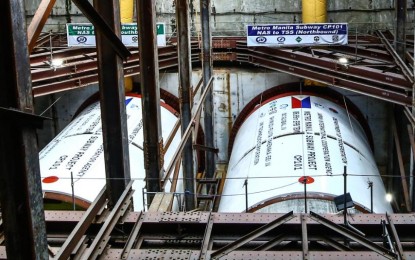
TUNNEL DIGGING. Two tunnel boring machines are showcased during a site visit at the under-construction North Avenue Station of the Metro Manila Subway Project in Quezon City on March 7, 2024. President Ferdinand R. Marcos Jr. said the country is in the midst of a railway renaissance, with several big-ticket rail projects already in full swing. (PNA photo by Joan Bondoc)
MANILA – Several railway projects mark a “renaissance” in rail transport, President Ferdinand R. Marcos Jr. said during his 3rd State of the Nation Address on Monday.
In his speech, Marcos showcased the Metro Manila Subway Project (MMSP) for accomplishing “significant” progress in its tunneling works.
“Sa puntong ito, katumbas na ng tatlo hanggang anim na palapag ang lalim ng nahukay, at tuloy-tuloy na umuusad sa susunod na istasyon (At this point, the digging is comparable to three to six floors, and it continues to move towards the next station),” he said.
According to the Department of Transportation (DOTr), the project is about 15 percent complete, with an estimated 1.3 km. of land dug from Valenzuela towards Quirino Highway in Quezon City.
On the other hand, the Metro Rail Transit Line 7 (MRT-7) and the North-South Commuter Railway (NSCR) are both progressing, with construction for both projects in full swing.
“We will make sure that right of way issues are resolved in the most equitable, efficient, and expeditious manner so that these will not get in the way of our infrastructure development,” he said.
Meanwhile, the Sucat-to-Baclaran expansion of the Light Rail Transit Line 1 (LRT-1) is set to open to the public within the year, with further extension towards Bacoor in Cavite to open in the next few years.
“Nagdagdag din tayo ng 76 na bago at modernong mga tren sa LRT-1 upang mas dumami, bumilis, at maging mas kumportable ang biyahe ng mga pasahero (We also added 76 new and modern trains at LRT-1 to provide more, faster, and comfortable journey for passengers),” he said.
He also announced the reopening of the Philippine National Railways (PNR) Bicol Line, which spans 100 km. from Naga City in Camarines Sur up to Legazpi City in Albay.
More seaports, airports
In addition to railway transport, the Marcos administration continues to build more seaports and airports to connect the country’s more than 7,000 islands with the rest of the world.
The operation and maintenance of the Ninoy Aquino International Airport will soon be in the hands of the private sector.
He expressed confidence that the private partnership would improve both the airport’s infrastructure and service in the coming years.
“Soon, it will be capable of accommodating 48 flights per hour, servicing our ever-increasing local and international flight routes, and catering to more than 62 million passengers per year,” he said.
To date, he said, more than 70 airport and seaport development projects have been completed and 350 more ongoing projects are going to be completed by 2028.
These completed projects include the expansion of the passenger terminal buildings (PTB) of the General Santos Airport and the Bicol International Airport by 300 percent and 500 percent – now catering to 2,000 and 1,600 passengers, respectively.
In addition, the Batangas Port PTB has been expanded to accommodate 8,000 passengers at any given time.
“Thanks to Congress, the Public-Private Partnership (PPP), as a crucial funding mechanism for big-ticket projects, is now institutionalized by force of law,” he said.
The PPP, he said, is expected to facilitate strategic investments and timely development of projects under the administration’s “Build Better More” program.
“Around one-fourth of our flagship projects have been envisioned to be funded through this modality,” he said.
"PPP is seen to facilitate strategic investments and the timely development of projects under our ‘Build Better More’ program, especially since around one-fourth of our flagship projects have been envisioned to be funded through this modality.” (PNA)
